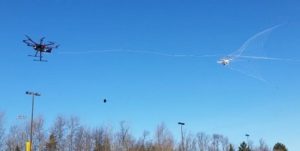
Whether it’s the latest “anti-drone rifle by Batelle Innovations or the Orwellian-sounding “anti-drone death ray” Anti–AUV Defense System, new products that frazzle or knock down UAV systems will likely grow alongside drone innovation. Case-in-point: The “robotic falcon” drone catcher by Michigan Technological University.
The university’s drone catcher project deploys a drone of its own equipped with a launcher that can shoot a large net to capture rogue drones without explosives.
Mechanical engineering professor Mo Rastgaar conceived the idea as he was watching World Cup soccer. Someone told him that snipers at the stadium were stationed to shoot down any possible threats.
“I thought, ‘If the threat is a drone, you really don’t want to shoot it down—it might contain explosives and blow up. What you want to do is catch it and get it out of there,’” Rastgaar said in a Michigan Tech press release.
His team’s new “drone falcon” system can be controlled by a ground-based human user but can also operate autonomously or in a hybrid mode.
“After an intruding drone is spotted, the drone catcher takes up the chase and fires the net at it from a distance of up to 40 feet,” a Michigan Tech spokesperson said. “Because the net is so big and can be deployed so quickly, it can overwhelm even the fastest, most maneuverable small drone.”
Rastgaar adds:
“It gets really entangled — it’s not going anywhere. Then the net swings down below the drone catcher, which ferries its cargo to a safe location. What makes this unique is that the net is attached to our catcher, so you can retrieve the rogue drone or drop it in a designated, secure area. It’s like robotic falconry.”
Rastgaar said he hopes law enforcement will use his concept to enforce the FAA’s new drone registration regulations, shooting down rogue, unregistered drones.
Marrying drones with some kind of netting system is not a new anti-drone strategy. In December the Tokyo Metropolitan Police Department announced the launch of a drone squad that can capture nuisance drones flown by members of the public. As reported in DRONELIFE: “The drone squad will operate large drones with specially designed nets to catch rogue drones flying in restricted airspace, such as over important buildings or crowds. The MPD drone will carry a long rectangular net hanging beneath it to cover the propellers of the rogue drone and capture it without causing the drone to crash.”
Jason is a longstanding contributor to DroneLife with an avid interest in all things tech. He focuses on anti-drone technologies and the public safety sector; police, fire, and search and rescue.
Beginning his career as a journalist in 1996, Jason has since written and edited thousands of engaging news articles, blog posts, press releases and online content.
Email Jason
TWITTER:@JasonPReagan
Subscribe to DroneLife here.